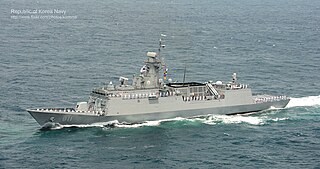Incheon-class frigate

Incheon-class frigate
|
|
| Class overview | |
|---|---|
| Name: | Incheon class |
| Builders: | |
| Operators: |
|
| Preceded by: | |
| Cost: | $232 million |
| In service: | Batch I: 6 |
| Building: | Batch II: 1 |
| Planned: | 18 to 24 |
| Completed: | Batch I: 6 |
| General characteristics | |
| Type: | Coastal defense frigate |
| Displacement: |
|
| Length: | 114 m (374 ft), 122m (Batch II) |
| Beam: | 14 m (46 ft) |
| Draft: | 4 m (13 ft) |
| Propulsion: |
|
| Speed: |
|
| Range: | 4,500 nautical miles (8,000 km) |
| Complement: | 140 |
| Sensors and processing systems: |
|
| Electronic warfare & decoys: |
|
| Armament: |
|
| Aircraft carried: | Super Lynx or AW159 |
| Aviation facilities: | Flight deck and enclosed hangar for up to one medium-lift helicopters |
The Incheon-class frigates (Hangul: 인천급 호위함, Hanja: 仁川級護衛艦), also known as the Future Frigate eXperimental or FFX during development, are coastal defense frigates of the Republic of Korea Navy. The lead ship was launched on 29 April 2011. The Incheon-class frigates will replace the aging fleet of Pohang-class corvettes and Ulsan-class frigates, and take over multi-role operations such as coast patrol, anti-submarine warfare and transport support. Later batches are planned to be specialized on anti-air and anti-submarine warfare.
In the early 1990s, the Korean government plan for the construction of next generation coastal ships named Frigate 2000 was scrapped due to the 1997 Asian financial crisis. But the decommissioning of the Gearing-class destroyers and the aging fleet of Ulsan-class frigates, the plan was revived as the Future Frigate eXperimental, also known as FFX in the early 2000s.
The Republic of Korea Navy initially wanted twenty-four 3000 ton frigates to replace the Ulsan-, Pohang- and Donghae-class coastal fleet of 37 ships. It was later decided that six 2700 ton ships will be constructed for the first batch. In 2008, the plan was further downgraded to 2300 tons when president Lee Myung-bak took office, with the number of ships for the first batch down to six. 6-9 ships are planned for the second batch of FFX with the final goal of 20-24 frigates.
Batch II vessels are to be built by DSME with the twin gas turbine layout replaced with a single Rolls Royce MT30 turbine engine, and propulsion will be all-electric. Other changes include a 16-cell (KVLS) with longer-ranged surface-to-air missiles and the use of anti-submarine missiles, and a larger hangar for a 10-ton helicopter.
In 2010 the construction of the first FFX frigate was awarded to Hyundai Heavy Industry and in April 2011 the first of its class, ROKS Incheon was launched. The ship is named after the western port city of Incheon, representing the Republic of Korea Navy's initiative to defend the western islands due to the constant clashes with the North Korean navy in this area.
...
Wikipedia
